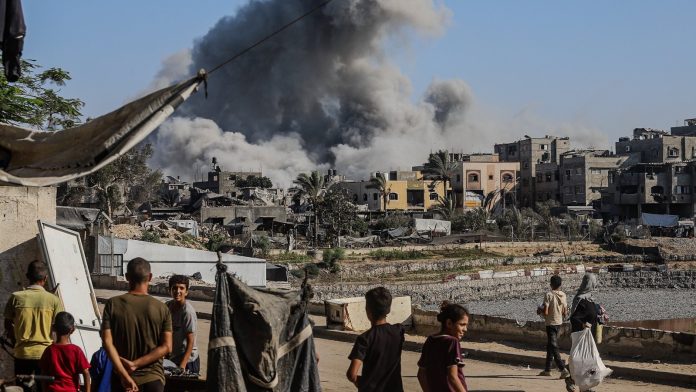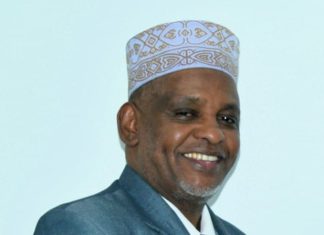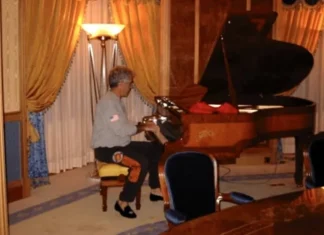On the Brink: The Urgent Call to Halt Gaza’s Descent into Deeper Conflict
As twilight deepened over Tokyo, United Nations Secretary-General Antonio Guterres raised his voice at the International Conference on African Development with a plea that echoed far beyond the city’s neon-lit skyline: an immediate ceasefire in Gaza. His words, tinged with the gravity of mounting tragedy, cut through global headlines—especially as Israel advanced its military operation aimed squarely at Gaza City’s heart.
“It is vital to reach immediately a ceasefire in Gaza,” Guterres implored. The urgency was unmistakable. “To avoid the death and destruction that a military operation against Gaza City would inevitably cause.”
Behind this appeal lies the tempestuous reality on the ground—where the already densely populated Gaza Strip, home to some 2.3 million Palestinians, stands on the verge of calamity.
A City Poised on the Edge of Catastrophe
Israel, having mobilized tens of thousands of reservists, is pressing ahead with its plans to seize control over Gaza City, the largest urban center in the territory. Military spokespeople assert that troops are now operating around the city’s outskirts, describing Hamas, the governing authority in Gaza, as “battered and bruised.” But what does that actually mean behind the front lines, in cramped homes and narrow alleys?
Chris McIntosh, humanitarian response advisor for Oxfam in Gaza, serves as our eyes and ears within this besieged metropolis. His report sends chills. “The situation is extremely tense. There’s still so much uncertainty, a cloud over what will come next.”
Mass displacement—once an abstract possibility—is rapidly morphing into an impending nightmare. “From a humanitarian perspective, this would be an absolute catastrophe,” McIntosh warns. Every corner of Gaza City feels the pressure; families who have endured years of blockade and intermittent conflict now face the prospect of being uprooted once again.
“Physically, the people here reflect the mental toll: exhaustion, malnourishment, starvation. It’s a population under siege not just by bombs but by deprivation itself,” McIntosh elaborates.
Restricted zones have been imposed by Israeli forces, squeezing residents into what amounts to just 30% of Gaza’s land where they can still find refuge. Imagine collapsing millions of people into tighter and tighter spaces, where basic resources become even scarcer—a pressure cooker that threatens to ignite any moment.
Counting the Cost: Lives Lost and a Spiraling Conflict
The casualties tell their own bleak story. According to Gaza’s health ministry, Israeli strikes have killed at least 60,000 people since the violent eruption of conflict in October 2023. This latest showdown dates back to Hamas’s surprise attack on October 7th, which targeted southern Israeli communities and stunned the world.
Over 1,200 Israelis—mostly civilians—were killed, with 251 taken hostage by Hamas, including many children. Israel’s subsequent military response has been among the most intense and destructive in Gaza’s history.
In the midst of this maelstrom, Guterres also called for the unconditional release of those hostages, pressing for a thread of humanity to remain visible where so much has been lost.
The Controversial Shadow of Illegal Settlements
Adding another layer of complexity to this tinderbox, the UN Secretary-General condemned Israel’s recent approval to expand illegal settlements in the occupied West Bank. According to the UN’s human rights office, the plan to build thousands of new homes between an Israeli settlement and East Jerusalem flagrantly violates international law.
The move threatens to sever the West Bank’s already fragile connection to East Jerusalem, intensifying the risk of forced evictions and potentially committing what the UN calls a war crime. To Palestinians, this isn’t just a policy—it’s a deeply personal blow.
The Palestinian Foreign Ministry decried the expansion as a stark attempt to isolate Palestinian communities and undermine any hope for a viable two-state solution, which has rested on a razor-thin thread for decades.
Voices from Both Sides: Raised Doubts and Stark Realities
On Israeli airwaves, Eran Etzion, the former deputy head of Israel’s National Security Council, voiced sharp criticism of the plan to take full control of Gaza City.
“It’s highly controversial—not just within Israel but internationally,” Etzion told RTÉ’s Morning Ireland. “Some of Israel’s top military officials, including the chief of staff, have warned that entering Gaza City could be a death trap for soldiers.”
Yet, despite these warnings, Prime Minister Benjamin Netanyahu’s government pushes ahead.
Etzion argued this move is driven less by national security interests and more by political aims—specifically, Netanyahu’s personal agenda. “There’s a messianic zeal among certain factions in the government,” he said, “a minority, but one with increasing influence.”
Indeed, the plan to control Gaza City and potentially uproot its population downplays the complex human cost involved. It underscores a grim trend of territorial expansion entwined with political ambition—a pattern that resonates throughout the region’s turbulent history.
What Does the Future Hold?
So, where do we go from here? The story unfolding in Gaza is not a distant geopolitical chess match; it’s about real lives—wives, husbands, children, elders—caught in the crossfire of a long and agonizing conflict.
It begs reflection: In a world interconnected as never before, how do we respond when mass displacement looms once more, when children grow up knowing only war and trauma? How do global communities hold leaders accountable when international law is so openly challenged?
And beyond Gaza’s borders, the creeping construction of settlements and territorial divisions signal a looming fracture that could shatter any remaining hopes for peace.
Is there a pathway to reconciliation? Can dialogue and international pressure steer this volatile situation away from further disaster?
Looking Beyond the Headlines: The Larger Picture
This moment—fraught with tension, despair, and political complexity—mirrors a troubling global trend. Across various conflict zones, the lives of civilians are often subsumed by strategic ambitions. The Gaza crisis reminds us sharply of the urgent need for a global commitment to human dignity, ceasefires, and lasting peace.
For those of us watching from afar, the question must be posed: How do we transform compassion into action? What stories do we choose to amplify? How do we stand with those whose voices are strangled by violence?
Antonio Guterres’s plea in Tokyo was more than diplomatic rhetoric. It was a call to conscience in a world hungry for justice and mercy.
In Their Words
- Antonio Guterres, UN Secretary-General: “Immediate ceasefire is paramount to prevent a humanitarian catastrophe.”
- Chris McIntosh, Oxfam, Gaza City: “People are squeezed into tighter spaces. The physical and psychological toll is unbearable.”
- Eran Etzion, Former Deputy Head, Israel’s National Security Council: “The plan to enter Gaza City could be a death trap—driven more by political agenda than national interest.”
- Palestinian Foreign Ministry: “Illegal settlement expansion threatens to wipe out what’s left of the two-state solution.”
In the shadow of drones and distant rocket fire, human stories pulse with hope, desperation, and resilience. And the world watches, waiting to see which thread will unravel first—violence or peace.










